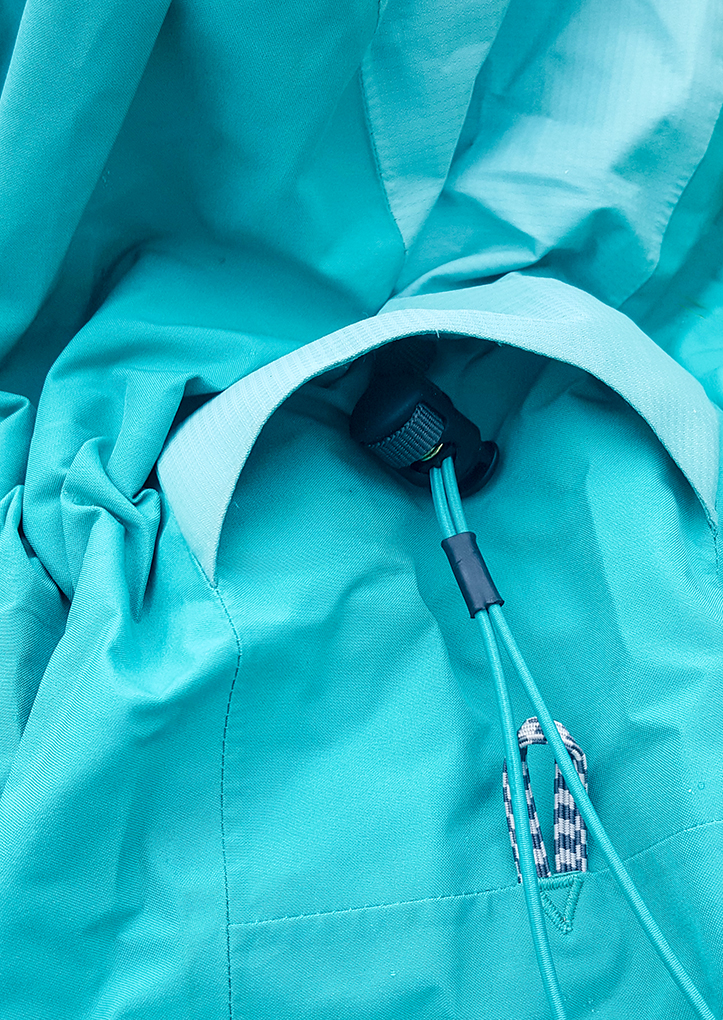Hood
The hood easily accommodates a helmet, and the adjustable draw strings in the back of the hood and around the face allow you to synch it down when you’re not wearing a helmet.
The drawstring in the back of the hood is very easy to pull in or release while you’re still wearing the jacket, which was a relief compared to other adjustable hoods I’ve worked with in the past, like the Black Diamond Dawn Patrol softshell. With the Dawn Patrol, I had to pull my gloves off and free both hands to adjust the back of the hood.
With the Alpine Front, there is a rubber sheath around the two elastic strings that you can pull away from the hood to release the drawstring and expand the hood, then with one pull of the plastic toggle in the back, the cord tightens down for when you’re not wearing a helmet.

I did find that expanding the elastic band around the face portion of the hood was a little harder to accomplish with the jacket still on. I can’t say that I’ve totally figured out the trick with it, but upon taking off the jacket and re-working the elastic back through the hood, I was able to expand it back out.
While the Alpine Front jacket doesn’t adjust easily around the face of the hood, it is less difficult to work with than the Torrentshell. The design that Black Diamond uses for adjusting the face of the hood is the best I’ve used. They have a larger toggle near the cheek on the hood that you can easily squeeze with one hand, then pull the hood up with the other to release the elastic.
Overall, the Alpine Front hood’s firm bill and two-way adjustable straps worked well at keeping rain off my face while moving in the mountains and canyons.
Construction
Eddie Bauer uses their own 2.5-layer material called “WeatherEdge Pro,” which has mm/24hr rating of 20K/20K. For a more in- depth look at what this means, check out our Outerwear 101 article.
The fabric is treated with a StormRepel DWR to help the fabric shed moisture.
For comparison, Gore-Tex PacLite material has a mm/24hr rating of 28K/15K; Gore-Tex Pro-Shell’s rating is 28K/25K; and eVent’s rating is 30K/22K.
Many other jackets on the market are not quite as waterproof or breathable. For example, Columbia’s Omni-Tech jacket has a rating of 10K/10K; Marmot’s PreCip is 15K/12K; and Sierra Designs’ Hurricane jacket is 8K/2K. Point is, WeatherEdge Pro is right up there in terms of water resistance and breathability.
Waterproofing
I was impressed by the WeatherEdge Pro material in this jacket, but not so much by the StormRepel DWR coating: the first time I wore the Alpine Front was on a canyoneering trip with 8th graders in southeastern Utah in early May, and we encountered several storms. At first I thought that the jacket was not working because it appeared that the rain was soaking into the shell. However, when we got into a cave to get out of the storm, I shook off the jacket and found that I was bone dry underneath. While the DWR coating wasn’t doing the best job of keeping water out of the jacket, the fabric’s membrane did an excellent job of making sure none of that moisture made its way inside.
Since that first day of wear, I have been impressed with the water resistance of this jacket. During Outward Bound training in the Sangres in late May, we had lightning storms and downpours every afternoon, and I was never wet or uncomfortable.
Breathability
I tend to run very hot, so breathability is an important factor for me. While hiking with a full pack every day in 60-70 degree conditions, I never felt like I was building up sweat inside the jacket, and while I did unzip the armpit vents and the mesh-backed front pockets to dump heat, I didn’t notice any moisture build up in my base layers. I found that my Patagonia Torrentshell did not breathe as well as the First Ascent Alpine Front Jacket, and I often built up sweat in my base layers as a result.
During our final day in Utah, we had a severe lightning storm roll up on us, so I found myself speed walking with my full pack on for five miles in 80 degree heat to get to the van, and I never needed to take the jacket off. Also, on ridgelines and during descents, I found that the jacket was quite windproof
Weight / Packability
With a stated weight of 369g, the Alpine Front is in about the same class as other uninsulated hardshells on the market. The super lightweight Patagonia Torrentshell and Montane Featherlite weigh in at only 286g and 284g respectively, but most other hardshells in this same category weigh in between 380g and 425g.
The Alpine Front packs down fairly small, but it isn’t a PacLite jacket that folds up into its own pocket, so it does still take up some space in the pack. However, taking into account the considerably wet season we’ve had in Colorado this year, I wouldn’t have wanted a hardshell that was any smaller or lighter if that compromised the water resistance and breathability that this jacket provided.
Price
At $199, the Alpine Front Jacket is slightly higher priced than other hardshell jackets in its class, such as Patagonia’s Super Cell ($188) or Torrentshell Jacket ($129). However (for the sake of comparison) all of Black Diamond’s hardshells are significantly more expensive.
Bottom Line
While there are hardshells out there that are a bit less expensive, in my opinion, the WeatherEdge Pro fabric, stretchy shoulders and elbows, great fit, and excellent breathability make the First Ascent Alpine Front Jacket a very good choice for any summer trip that comes with the possibility of precipitation.
